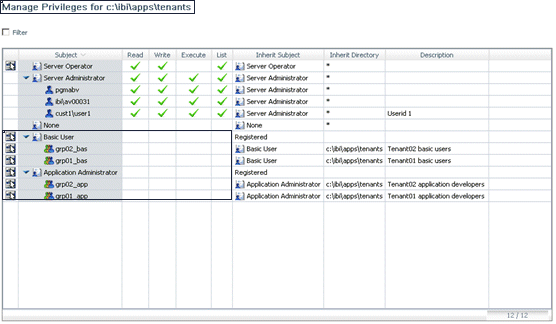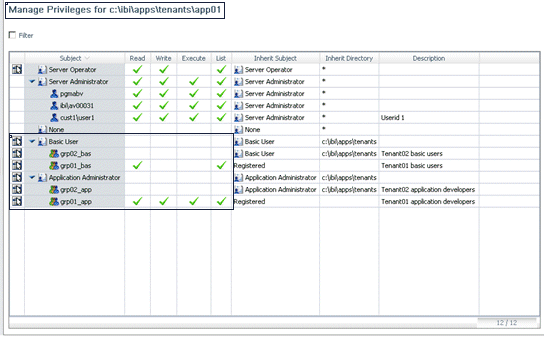Very often, multiple tenants in a multi-tenant environment
have an identical security structure, Each tenant has an identical
set of application folders and groups that conform to a standard
naming convention that includes the tenant ID in the name of each
subgroup and application folder. The folder and group setup is repeated
from one tenant to the others. In most cases, tenants have no access
rights outside of their main application folder.
In this type of configuration, you can establish file privileges
for a model tenant and its associated groups, and dynamically apply
them to other tenant groups by creating a template based on the
model tenant. The template defines regular expressions that identify which
actual group names should be assigned file privileges based on that
template. Each group ID should match only one template.
x
Procedure: How to Configure Security Templates
The
following steps outline the tenant management process in the Reporting Server.
-
Identify
the tenant root application folder.
The tenant root application folder can be under
approot or can be a mapped application or SQL mapped folder. The
application must be in the APP PATH. For example, c:\ibi\apps\tenants.
-
Set the
permission for this folder to no access for all non-server administrator
roles. in order to prevent tenants from accessing folders assigned
to other tenants.
-
Using the
established naming convention, create the model tenant folder under
the tenant root. Give the model tenant groups explicit access permissions to
the model folder and its subfolders.
The model tenant groups must follow the tenant
group structure and naming conventions established in the security
software for the installation. The model group must be registered
in the admin.cfg file. If the security provider is PTH, the tenant groups
must also be registered in the admin.cfg file.
For
example, using the departments application as the tenant root, create
the sales application under the tenant root.
The server administrator creates the groups sales, sales/dev, sales/basic,
and any other groups needed.
In
the following image, the tenant root folder is called departments,
and the sales application is the model application.
The sales application is not only a model, it is an existing group
or tenant that must be registered, with privileges to the application departments/sales.
Once you create one registration you can assume it as the model and
create a template based on it:

The
server administrator defines the file and directory privileges for
the sales, sales/dev and sales/basic groups on the sales folder
and its children. These privileges will be replicated in groups
for other tenants when their group ID matches one of the established
template group IDs.
The following image shows that
the sales group, whose role is Basic User,
has been given Read, Execute, and List privileges on the sales folder:
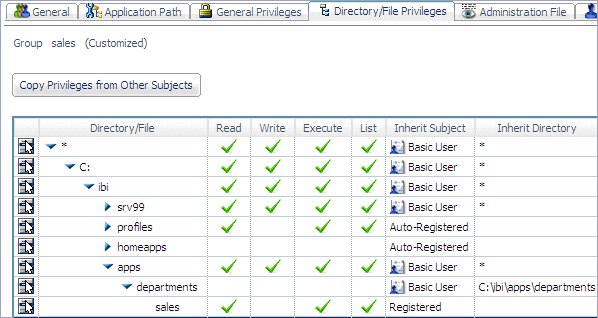
-
Establish
a template that specifies how the model access rules are replicated
to other tenants.
-
On the Access Control page, right-click the Templates folder
and select Register Group Template from the
context menu:
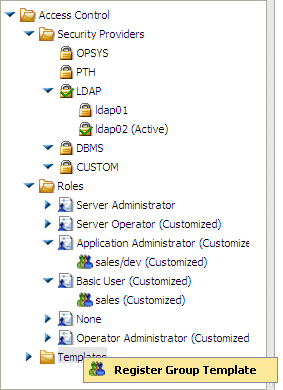
The Group Template Registration page
opens:
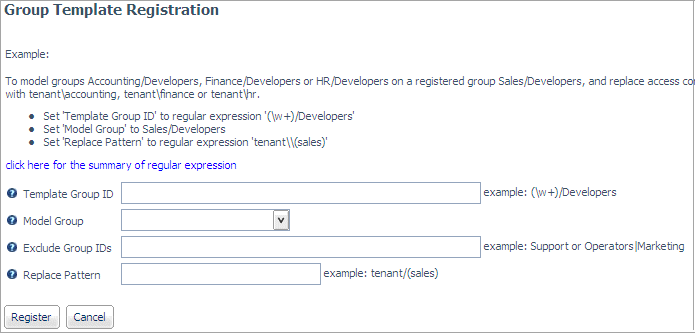
-
Enter the following values to establish the rules for deriving access
control privileges for groups that match the template, and click Register:
- Template Group ID
-
Is a regular expression that must contain a tagged
expression. The tagged expression is used to identify a part of
the model group ID that will be replaced by the corresponding characters
in the actual group ID passed to the Reporting Server for the connected
user.
For information about regular expressions,
see Summary of Regular Expressions.
- Model Group
-
Identifies the group that will be replicated.
- Exclude Group IDs
-
Is a regular expression that identifies any group
IDs that should be excluded in the template matching process.
- Replace Pattern
-
Is used for admin_privilege strings to model file/directory
privileges from the model group registration to a target group.
For example, the sales
application has the sales/dev group that is registered with specific
privileges on the sales folders. When the finance application is
created, it will have a group named finance/dev that will be assigned
the same privileges on the finance folders that the sales/dev group
has on the sales folders. The finance groups will not be registered,
but the template describes how to replace the word sales with
the word finance when the group name ends
with the characters /dev.
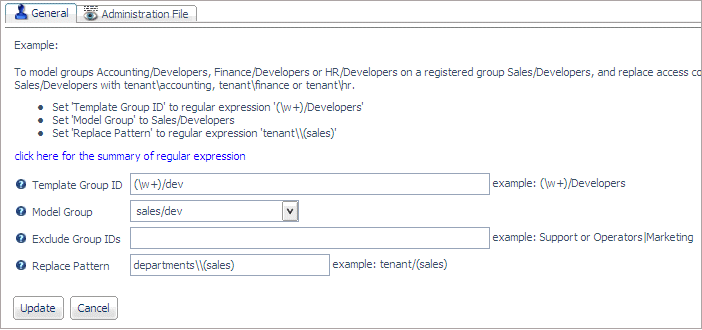
When
you register the template, the following attributes are added to
the admin.cfg file:
admin_group_template = (\w+)/dev
BEGIN
model_group = sales/dev
file_replace_pattern = departments\\(sales)
END
For example, the template group ID pattern
(/w+)/dev specifies that any word followed by the characters /dev
matches the template pattern.
The replace pattern departments\\(sales)
indicates that the text sales will be replaced.
If the group ID finance/dev is passed to the Reporting Server, the
tagged expression in the Template Group ID will cause the characters finance to
replace the characters sales in order to
determine the file privileges for the connected user. Therefore,
a user in the group finance/dev will inherit the privileges under
the finance tenant application that the group
sales/dev has under the model sales application.
To create a template that applies to
the group sales, you need to make sure that
you exclude other group names that start with the characters sales/ because
without the exclusion, sales will match all of the templates, and
it may be assigned the wrong one. The following image shows the
template for the sales group:

The
regular expression (/) in the Exclude Group IDs field specifies
that group names that contain a slash do not match the template.
For information about regular expressions, see Summary of Regular Expressions.
At this point, the system
is ready to add new tenants.
To add a new tenant (for
example, finance), the server administrator must create the finance
application under the tenants root application. The installation
must provision groups and users (that conform to the established
naming conventions) in the relevant security provider, for example
LDAP, OPSYS, or Custom. This is done outside of Information Builders
software. The new tenant is now ready to be used. No access control
for it needs to be established by the server administrator. The
server will dynamically assign the access control privileges based
on the model and the template.
For example, the user
fbas1 (which is part of the finance group) logs on. The properties for
this user show that the user has Read, Execute, and List privileges
on the finance folder because the sales model group was given those
privileges on the sales folder:
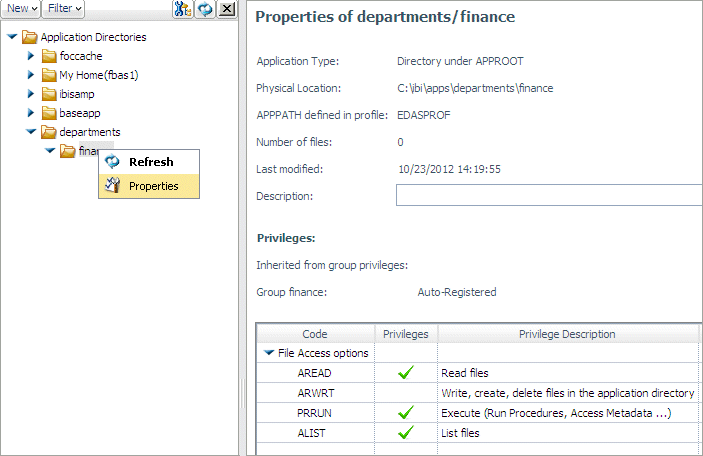
Note
that the sales tenant is not visible to this user,
x
Reference: Summary of Regular Expressions
A
regular expression is a string containing a tagged expression. A
tagged expression is a portion of the string that will be replaced
with actual characters passed to the Reporting Server in the group
ID for a user.
Tagged expressions must be enclosed in
parentheses. The backslash character (\) is a special character
in tagged expressions. If a group ID actually contains a backslash character,
you indicate that you want the backslash character to be treated
as a normal character by entering two successive backslash characters
(\\).
The following can be
used to create the tagged expression:
- abc
-
Matches abc anywhere within
the string.
- (abc)
-
Matches abc anywhere within
the string, but the parentheses act as a tag.
- []
-
Defines a character class (or set) that matches
any one of the characters in the class. For example, [abc] matches
the character a or b or c. The expression [x-y] matches any character
from x to y.
- .
-
Matches any single character except newline.
- \w
-
Matches any word character string (alphanumeric
plus "_").
- \W
-
Matches any non-word character.
- \s
-
Matches any whitespace character.
- \S
-
Matches any non-whitespace character.
- \d
-
Matches any digit.
- \D
-
Matches any non-digit character.
- \t
-
Matches a tab character.
- \r
-
Matches a return character.
- \f
-
Matches a formfeed character.
- \e
-
Matches an escape character.
- \b
-
Matches a word boundary or a backspace. For example,
test\b matches test, but not testing. However, \b matches a backspace
character when specified inside a class (that is, [\b]).
- \B
-
Requires that there is no word boundary. hello\B
matches hello, but not hello there.
- ^
-
Matches characters only at the beginning of the
string. For example, ^abc matches abc at
the beginning of the string.
- $
-
Matches characters only at the end of the string.
For example, abc$ matches abc at the end
of the string.
- |
-
Specifies alternative matching characters. For example,
a|b matches either a or b. This metacharacter can also be used with
words, for example, abc|def.
- [^abc]
-
Matches a character that is not in the set. [^abc
]+ will match such strings as hello, test,
and perl.
- \
-
Is the escape character. For example, \* matches
the * character. Use the backslash (\) character to escape (remove
the special meaning of) characters that have significance in a
regular expression.
- (?i)
-
Ignores case. For example, (a(?i)b|c) matches aB, c,
and C.
You
can follow any character, wildcard, or series of characters and/or
wildcards with a repetition indicator:
- *
-
Matches 0 or more occurrences of the character sequence.
- +
-
Matches 1 or 0 occurrences of the character sequence.
- ?
-
Matches 0 or more occurrences of the character sequence
or the shortest match.
- {}
-
Is the repetition modifier.
- {n}
-
Matches exactly n occurrences
of the character sequence.
- {n,}
-
Matches at least n occurrences
of the character sequence.
- {n,m}
-
Matches at least n but not
more than m occurrences of the character
sequence.
